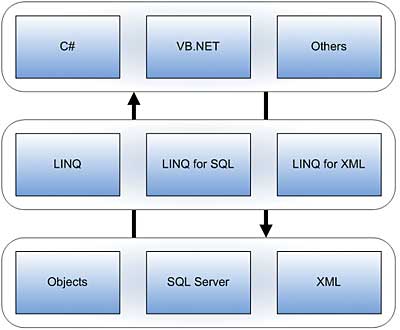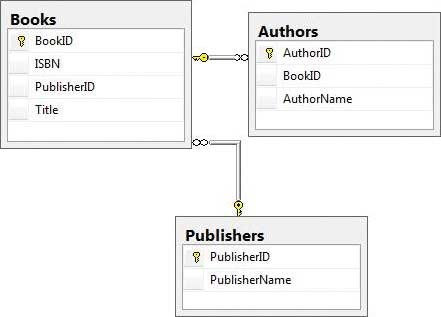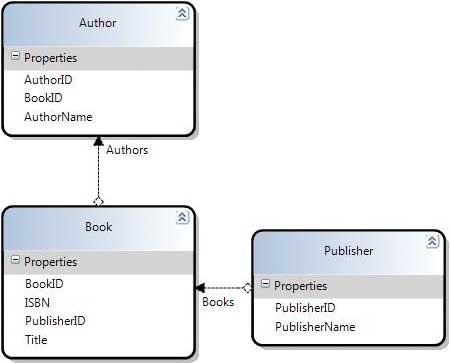In the past developers have had to spend many hours creating trivial data access layers like that in the listing below so that applications can interact more fluently with their chosen data store.
//...
public List<Book> GetBooks()
{
List<Book> bookList = new List<Book>();
using (SqlConnection sqlConn =
new SqlConnection(_conn))
using (SqlCommand cmd = new
SqlCommand("SelectBooks", sqlConn))
{
cmd.CommandType =
CommandType.StoredProcedure;
sqlConn.Open();
SqlDataReader sqlRdr =
cmd.ExecuteReader();
while (sqlRdr.Read())
{
bookList.Add(new
Book((int)sqlRdr.GetInt32(0),
(string)sqlRdr.GetString(1),
(int)sqlRdr.GetInt32(2),
(string)sqlRdr.GetString(3)));
}
}
return bookList;
}
// ...
Typically these data access layers would use SQL queries and map their results to a collection of custom types. This was fun the first time we did it many years ago, but quite frankly we are now starting to question our own sanity – mention a data access layer (DAL) again, and we might just scream!
In this article we will discuss how LINQ for SQL can help us create more intuitive, flexible DAL’s with a lot less code. Unfortunately we cannot just dive in without first setting the scene.
By the time you have read this article you will be familiar with key concepts introduced in LINQ and LINQ to SQL. With this new-found knowledge, you will be able to construct more powerful DAL’s for your applications to interact with.
Advantages of using LINQ for SQL
Many developers have been intimidated by complex Object Relation Mapping (ORM) software due to the complexities of replicating a conceptual model of their database schema. One of the major advantages of using LINQ to SQL is that the complexity is taken away from the developer; new types have been included in ADO.NET vNext (the next version of ADO.NET), which easily allow you to express relationships between entities. Developers will benefit from being able to step through queries while debugging, and get intellisense when constructing queries, resulting in a more comfortable and robust programming environment.Furthermore, the public May CTP of LINQ includes a number of tools for us to use which automate the process of constructing our conceptual entity view of our database schema.
For more information on mapping to relational databases using objects refer to Patterns of Enterprise Application Architecture by Martin Fowler.
Understanding LINQ
Before we apply LINQ queries to entities we must first familiarize ourselves with exactly what LINQ is. In this section we will look at code examples of LINQ in action as well as provide a core understanding of the new features in C# 3.0 which LINQ uses extensively.Overview of LINQ
In the overview diagram (Figure 1) we can see that there are several components to LINQ, the middle tier of technologies which include LINQ, LINQ for XML, and LINQ for SQL can be utilized by both C# and VB.NET and potentially other languages.
Figure 1: The structure of LINQ
Each middle tier component provides us with the required functionality to interact with that component’s data store.
Getting up and running with LINQ is simple – it requires a one-off download of the LINQ May CTP. The CTP includes:
- C# 3.0/VB.NET 9.0 compiler (includes LINQ, LINQ for SQL and LINQ for XML namespaces)
- Language reference update for Visual Studio 2005
- Project Templates for Visual Studio (includes Console Application, Win Forms, WPF, and Class Library)
- Two tools for automating the creation of entities (LINQ for Relational Data (DLINQ) recently renamed to LINQ for SQL), these include the DLINQ objects item (visual designer for Visual Studio 2005) and SqlMetal which is a command line utility.
- Sample applications
First LINQ Application
Let us dive in and take a look at LINQ in action by performing a query on an in-memory collection. The goal of this example is to get a core understanding of how a query is constructed and what types of collections you can query.// ...
string[] cities = { "London", "Paris",
"Berlin", "Moscow", "Dublin",
"Barcelona", "New York",
"Endinburgh", "Geneva",
"Amsterdam", "Madrid" };
IEnumerable<string> query = from c in
cities where c.StartsWith("M")
select c;
foreach(string city in query)
Console.WriteLine(city);
// ...
In this snippet we use several standard operators to construct a query which filters out all cities which start with the letter ‘M’, however, of more significant importance is the collection which we have queried. We can query any in-memory collection which implements IEnumerable, or IEnumerable<T>. The example previously shown calls the GetEnumerator() on the query when the foreach statement is executed, subsequently a while loop iterates over all items in the collection that satisfy the query until the MoveNext() method of the collection returns false.
If we run this example in debug mode, placing a breakpoint on the same line as the foreach statement, we can see that the compiler is doing some extra work for us under the covers (Figure 2).

Figure 2: Calling a lambda expression
An implementation detail of the query given above is that we are actually creating a lambda expression when the code is compiled, this expression is used as a parameter for Where() extension method of the cities collection.
Lambda expressions introduce a functional style of programming into both the C# and VB.NET languages. Constructing a lambda expression is simple using the new generic Func<A0 , ... , A4, T> type, which like all other examples which use LINQ-specific features so far, is a part of the System.Query namespace. We will now go ahead and replicate the previous query using lambda expressions:
Func<string, bool> filter = c =>
c.StartsWith("M");
var query = cities.Where(filter);
foreach(string city in query)
Console.WriteLine(city);
Here we define a lambda expression which takes a single string parameter and returns a bool, a lambda expression typically takes the following structure: parameters => expression. Another thing to note is that we call an extension method called Where() on the cities collection which takes a predicate as an argument, extension methods exist for several common query operators including Select, OrderBy, SelectAll, etc. For a full reference see the official LINQ project site.
To learn more about functional programming I would strongly recommend you look at the Haskell language.
LINQ for SQL
Formerly named LINQ for Relational Data (DLINQ), LINQ for SQL allows us to interact with a conceptual view of our database. Before we look at LINQ for SQL we must first talk a little about entities, and the tools that exist to automate the generation of our conceptual database model.Defining Entities
An entity by definition is something that is distinct and exists as a separate existence, in LINQ for SQL, entities are defined using custom types and attributing those types’ up with a special new set of attributes included in the LINQ for SQL namespace (System.Data.DLinq). Using attributes we can associate an entity with a table in our database, we can also use attributes to define relationships and entity hierarchies amongst other things.
Figure 3: Simple books database schema (can be downloaded from gbarnett.org)
In the code snippet below we use attributes to associate a type of Author with the Authors table in our database (see Figure 3); we also define a property AuthorID and associate it with the corresponding column in the Authors table. Of particular significance is the use of DBType in the Column attribute – this has been introduced because not all data types in SQL Server map directly to a CLR type, for more information on supported database types see the official LINQ project site.
To associate an entity with a relation in our database, use
[Table(Name="Authors")]
public partial class Author
{
// ...
[Column(Storage="_AuthorID",
DBType="Int NOT NULL IDENTITY",
Id=true, AutoGen=true)]
public int AuthorID
{
// ...
}
// ...
}

Figure 4: DLINQ Objects designer
The demo database schema in Figure 4 describes a few relationships; we can define these exact relationships at our conceptual layer. In the System.Data.DLinq namespace there are two generic types which allow us to express relationships between entities, these are:
- EntityRef<TEntity> – In the Books table we have a 1:1 relationship with a record in the Publishers table; to define this at our conceptual layer we create an attribute of type EntityRef<Publishers>, the implication being that each Book entity has a single reference to a Publisher entity.
- EntitySet<TEntity> – In the sample schema, one book can have many authors (1..*). To define this at our conceptual layer we create an attribute of type EntitySet<Authors>. We imply that for every Book entity there is an associated set of Author entities.
// ...
[Association(Name=
"FK_Books_Publishers",
Storage="_Publisher",
ThisKey="PublisherID",
IsParent=true)]
public Publisher Publisher
{
// ...
}
// ...
For more information on attributes used to define relationships between entities refer to the official LINQ project site.
Tools
As we have seen, defining entities is simply a case of mapping an attributed type to a table. Although this process is very straightforward it can be time-consuming, especially when you have many tables in your database schema with many relationships. For this reason the LINQ May CTP includes two tools, one is a designer hosted in Visual Studio 2005 (DLINQ objects) and the other is a command line utility, SqlMetal. We will take a quick look at using the DLINQ objects item to create a conceptual view of our database schema.First go into Visual Studio and create a new LINQ Console Application, when the solution has been created add a DLINQObjects item to the solution. At the moment you will see a blank canvas, drag the tables of your database from the server explorer window onto the canvas – you have just created the conceptual view of your database schema. The main advantage of using the designer is that you are presented with an entity diagram (Figure_4) describing your conceptual model, however you will find the designer becomes very slow (it’s a CTP remember!) when creating a conceptual view for a large database schema, for that reason I recommend you use the SqlMetal command line utility if that is the case.
Querying Entities
Just like we can query in memory collections, we can also query entities in our conceptual database model. To interact with our conceptual database model we need to create a DataContext – this is a very important type in the System.Data.DLinq namespace. The DataContext object is in charge of converting rows to objects and vice versa when interacting with our conceptual model, a DataContext object takes a connection string, or any type that implements IDbConnection as an argument (e.g. SqlConnection). Here is the code for getting all book titles in the database:// ... BooksDataContext db = new BooksDataContext(_conn); IEnumerable<Book> query = from b in db.Books select b; foreach(Book item in query) Console.WriteLine(item.Title); // ...This code can be associated with the SQL statement:
Select * From BooksBecause we only want to select the Title property of the Book entity we can explicitly define this by returning a new anonymous type in our query which comprises of just the Title property of the Book entity.
Because we do not know the type of an anonymous type we can use the new variant type in C# 3.0. The type of a variant is inferred by its value, this allows us to use anonymous types very easily. Below we create a query variable whose type is inferred by the anonymous type passed back as a result of the query.
Anonymous types are types which are created at run time; of what type we do not know, however, the type created has CLR type safe properties. This code will pass back an anonymous type with a single property Title which is of type string:
// ...
var query = from b in db.Books
select new {b.Title};
foreach(var item in query)
Console.WriteLine(item.Title);
// ...

Figure 5: More efficient code generated by the DataContext object
Figure 5 shows the more efficient SQL generated by the DataContext object for this code.
Querying related entities
Next we will look at how we query related entities and look at the SQL generated by the DataContext to enable these queries.Because we defined the relationships between our entities using EntityRef<TEntity>, and EntitySet<TEntity> we can access related entities by using dot notation just like we would do to access methods, or properties of a normal type. The following query gets the Title of a Book and that book’s associated PublisherName.
// ...
var books = from b in db.Books select
new {b.Title,
b.Publisher.PublisherName};
foreach(var book in books)
Console.WriteLine("Title: {0}
Publisher: {1}", book.Title,
item.PublisherName);
// ...
We can access the PublisherName property of the Publisher entity from the Book entity as we have defined the Book entity as being the parent in the relationship to the Publisher entity.
![]()
Figure 6: SQL generated
Figure 6 shows the SQL generated by the DataContext for the above query.
For our final query we will get all the authors associated with each Book. Because there is a set of Author types associated with a Book we will need to create an inner loop using a foreach statement to iterate through the authors associated with any particular Book. The queries required to achieve this are:
var books = from b in db.Books select
new {b.Title,
b.Publisher.PublisherName,
b.BookID};
foreach(var book in books)
{
Console.WriteLine("Title: {0}
Publisher: {1}", book.Title,
book.PublisherName);
var authors = from a in db.Authors
where a.BookID == book.BookID
select new {a.AuthorName};
foreach(var author in authors)
Console.WriteLine(
author.AuthorName);
}
Summary
LINQ provides a simple set of standard operators to query in-memory collections as well as entities. LINQ for SQL allows us to create DAL’s quickly but more importantly they are more flexible and robust than the common approach we would take now as demonstrated in the first code snippet. Hopefully the code examples we have gone through in this article will provoke you into trying LINQ out for yourself!Granville Barnett’s interest in programming has spanned many languages – currently he is more than happy developing in C# (and the .NET framework in general), and C++. Granville’s blog is at gbarnett.org.
Comments